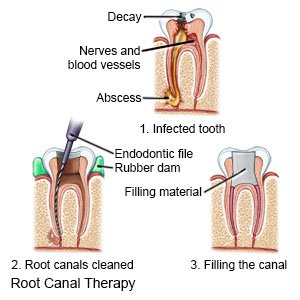Root Canal in Children
Medically reviewed by Drugs.com. Last updated on Apr 6, 2025.
What is a root canal?
A root canal is a procedure to remove diseased pulp from your child's tooth. The pulp is tissue that contains nerves and blood vessels that fill the tooth roots. Each root secures your child's tooth to his or her gum and jawbone. Your child may need a root canal if the tooth is damaged or infected. An abscess (pocket of pus), cavities, or an accident or injury can also lead to a root canal. A root canal can be done on baby teeth and permanent teeth. Baby teeth are meant to fall out on their own. If a baby tooth comes out too soon, your child can develop bite or speech problems. A root canal can help save the tooth and give it time to fall out when it is ready.
How do I prepare my child for a root canal?
- Your child's dental provider will tell you how to prepare your child for this procedure. Talk to your child about the procedure and why it is needed. Your child may feel scared to go to the dentist or to have a procedure. Help your child understand what will happen. Explain that he or she will get medicine to prevent pain.
- Depending on your child's age, the provider may use x-rays to examine the area. The pictures will show how bad the infection is and help your provider know the size and shape of the root canals.
- Your child will be given local anesthesia to prevent pain during the procedure. He or she may also be given antibiotics to help prevent an infection caused by bacteria. Tell the dental provider if your child has ever had an allergic reaction to an antibiotic or anesthesia.
- If your child has a filling or other dental device on the tooth, your dental provider will remove it. A rubber sheet will be put around the tooth. The sheet helps prevent saliva from entering the root canal. It also helps prevent your child from breathing in or swallowing liquids or small tooth pieces. The dental provider may drill a hole in the crown to reach the pulp and root canal.
Drugs used to treat this and similar conditions
Amoxil
Amoxil (amoxicillin) is a penicillin antibiotic used to treat many different types of infections ...
Omvoh
Omvoh is used to treat moderate to severe ulcerative colitis or Crohn's disease in adults. This ...
Vibramycin
Vibramycin is used for acne, actinomycosis, amebiasis, anthrax, anthrax prophylaxis, bacterial ...
Flagyl
Flagyl is used to treat bacterial infections of the vagina, stomach, skin and joints. Learn about ...
Doxy 100
Doxy 100 is used for acne, actinomycosis, amebiasis, anthrax, anthrax prophylaxis, bacterial ...
Doryx
Doryx is used for acne, actinomycosis, amebiasis, anthrax, anthrax prophylaxis, bacterial ...
What happens during a root canal?
- Your child's dental provider will insert tools into the root canals. The tools will remove the diseased pulp from the tooth with cleaning fluids. An x-ray may be taken to check for more pulp to remove. The provider will clean any remaining pulp from the root canal. After all of the pulp is removed, he or she will clean the open root canal with germ-killing liquid. The root canal will be dried and a filling will be put inside your child's tooth root.

- The dental provider will cover your child's tooth with a temporary or permanent crown. He or she may fill the root with a steroid paste to relieve any swelling in the root canal.
What happens after a root canal?
Your child may have some pain after the procedure. This is normal and should go away in a few hours. The dental provider may prescribe pain medicine or recommend an over-the-counter pain medicine, such as an NSAID. Ask your child's provider when your child can eat and drink again. Ask about any special instructions for caring for your child's tooth after a root canal. If a temporary crown is used, the provider will replace it with a permanent crown about 1 week later.
What are the risks of a root canal?
The cleaning fluid used to clean the root may enter nearby tissues and cause swelling, bruising, or an infection. The tip of a dental tool may get stuck in your child's root canal. Your child may swallow the tip if it drops into his or her mouth. Your child may get a fistula (abnormal tissue opening) between the tooth root and the sinus. The diseased tissue may not be completely removed. The root may not be completely filled, or the seal may not be tight. This means germs could enter your child's tooth and cause an infection. Your child may need another root canal, or the tooth may need to be removed.
Care Agreement
You have the right to help plan your child's care. Learn about your child's health condition and how it may be treated. Discuss treatment options with your child's healthcare providers to decide what care you want for your child. The above information is an educational aid only. It is not intended as medical advice for individual conditions or treatments. Talk to your doctor, nurse or pharmacist before following any medical regimen to see if it is safe and effective for you.© Copyright Merative 2025 Information is for End User's use only and may not be sold, redistributed or otherwise used for commercial purposes.
Further information
Always consult your healthcare provider to ensure the information displayed on this page applies to your personal circumstances.
